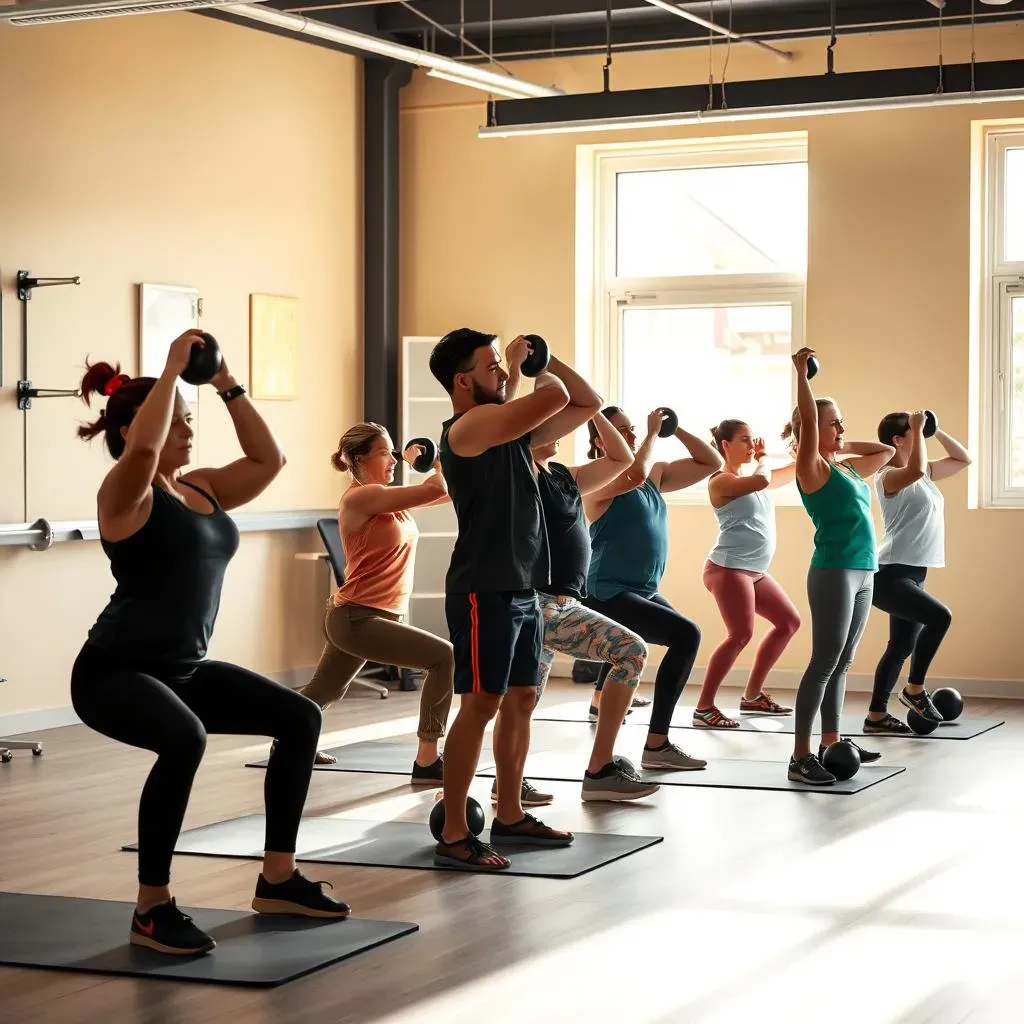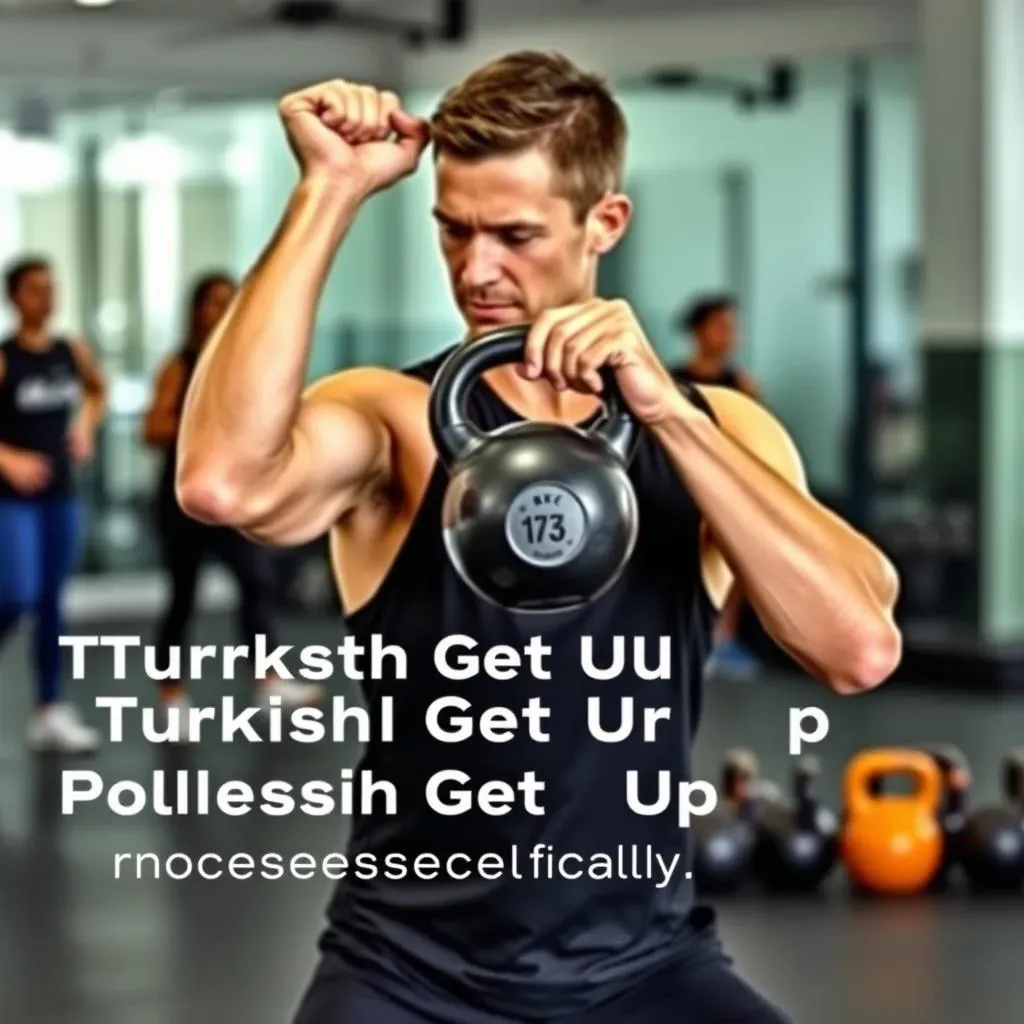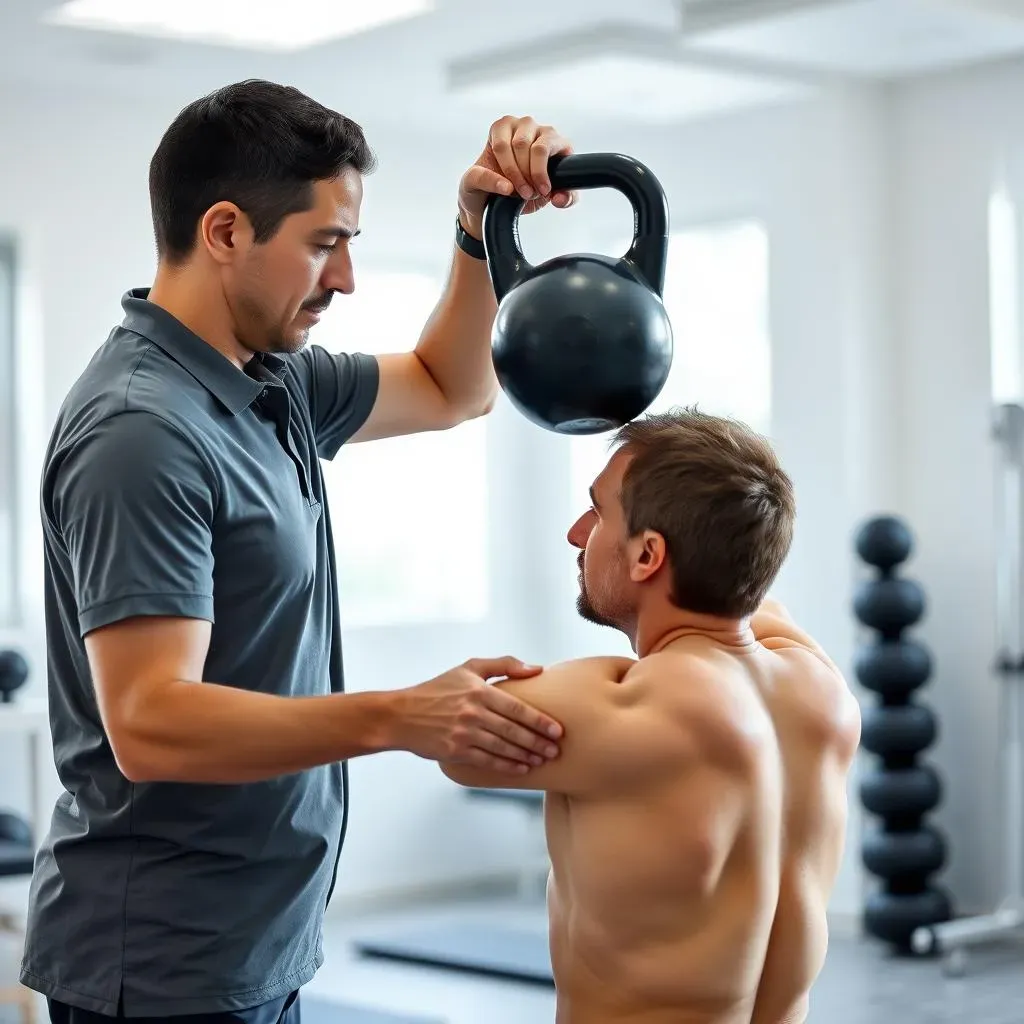Table of Contents
Dealing with a bum shoulder? You're not alone. Shoulder pain and injuries are super common, whether you're an athlete pushing your limits or just someone dealing with everyday wear and tear. But here's the good news: kettlebell shoulder rehab can be a game-changer. Kettlebells aren't just for building massive muscles; they're also incredible tools for restoring strength, mobility, and stability to your shoulder joint. Think of them as your secret weapon against pain and dysfunction. This article is your go-to guide for understanding how to use kettlebells to get your shoulders back in top shape. We'll break down the essential anatomy, highlight common shoulder issues, and then dive into seven key kettlebell exercises that can make a real difference. From the Turkish Get Up to the Kettlebell Halo, you'll learn how to perform each movement safely and effectively. Plus, we'll discuss how to integrate these exercises into a comprehensive rehab program. So, if you're ready to take control of your shoulder health, let's get started!
Understanding Shoulder Anatomy and Common Injuries

Understanding Shoulder Anatomy and Common Injuries
Let's dive into the shoulder – it's way more complex than you might think! It’s not just one joint; it’s a whole system of bones, muscles, ligaments, and tendons working together. We've got the humerus (upper arm bone), the scapula (shoulder blade), and the clavicle (collarbone) all playing key roles. The real magic happens with the rotator cuff, a group of four muscles – supraspinatus, infraspinatus, teres minor, and subscapularis – that wrap around the shoulder joint. These guys are the unsung heroes of shoulder stability and movement. They keep the head of the humerus snug in the glenoid fossa (the socket in your scapula), allowing you to lift, rotate, and reach without your shoulder popping out of place. Without a properly functioning rotator cuff, simple tasks become a real struggle.
Now, with all that complexity comes the potential for things to go wrong. Common shoulder injuries are often caused by overuse, trauma, or just plain bad luck. Rotator cuff tears are a big one, where one or more of those muscles get strained or torn. Impingement is another frequent issue, where tendons get compressed and irritated as they pass through the shoulder joint. Shoulder instability, where the humerus slips partially or fully out of the socket, can also cause significant pain and limit your range of motion. Understanding these potential problems is the first step in preventing them and knowing how to tackle them if they strike. It's all about knowing your body and how it works.
7 Essential Kettlebell Exercises for Shoulder Rehab

7 Essential Kettlebell Exercises for Shoulder Rehab
Turkish Get Up (TGU): The King of Shoulder Rehab
Alright, let's get into the nitty-gritty with some killer exercises. First up, we've got the Turkish Get Up, or TGU. Seriously, if you could only do one exercise for kettlebell shoulder rehab, this would be it. The TGU is a full-body movement that challenges your shoulder stability, mobility, and strength throughout a wide range of motion. You start lying on the ground with a kettlebell extended overhead, and then you methodically work your way up to a standing position, all while keeping that kettlebell stable. Then, you reverse the process to return to the starting position. Each step of the TGU forces your shoulder to stabilize and control the weight, building resilience and coordination like nothing else.
Think of it like this: the TGU isn't just about lifting weight; it's about controlled movement, body awareness, and engaging your entire kinetic chain. It’s like a moving meditation that strengthens your shoulder from every angle. It's a slow, deliberate process that demands focus and precision. Start with a light weight and gradually increase the load as your shoulder gets stronger. It’s not a race; it’s a journey back to full shoulder health.
Windmill: Unlocking Shoulder Mobility
Next on the list is the Kettlebell Windmill. This exercise is fantastic for improving shoulder mobility, stability, and core strength. You'll be standing with your feet wider than shoulder-width apart, holding a kettlebell overhead in one hand. Then, you hinge at your hips, reaching down towards the opposite foot with your free hand while keeping your eyes on the kettlebell overhead. The Windmill stretches the muscles around your shoulder joint, increasing flexibility and range of motion. It also challenges your core to stabilize your spine as you move, creating a strong and stable foundation for your shoulder.
The Windmill isn't just a stretch; it's an active mobility exercise that strengthens your shoulder in its newly acquired range of motion. It's like teaching your shoulder to move freely and confidently. Start with a light kettlebell and focus on maintaining good form. As you get more comfortable, you can gradually increase the weight. Remember, it’s not about how far you can reach; it’s about maintaining a stable shoulder and a straight arm throughout the movement. This is a great addition to any kettlebell shoulder rehab program.
Armbar: Opening Up the Shoulder Complex
The Kettlebell Armbar is an often-overlooked but incredibly effective exercise for shoulder health. You'll lie on your back with a kettlebell extended overhead, then roll onto the opposite side while keeping your arm straight and the kettlebell stable. This exercise gently opens up the anterior portions of the shoulder complex, including the anterior glenohumeral joint, pecs, and rib cage. It also improves proprioception, which is your body's ability to sense its position in space. The Armbar is like a gentle massage for your shoulder joint, releasing tension and improving circulation.
It's not about brute strength; it's about relaxation and controlled movement. The Armbar allows you to explore your shoulder's range of motion in a safe and supported environment. It’s like hitting the reset button on your shoulder joint. Start with a light kettlebell and focus on relaxing your shoulder muscles. As you get more comfortable, you can gradually increase the weight or hold the position for longer periods. The Kettlebell Armbar is a fantastic tool for anyone looking to improve their kettlebell shoulder rehab and overall shoulder health.
Technique and Progression in Kettlebell Shoulder Rehab

Technique and Progression in Kettlebell Shoulder Rehab
Mastering the Movement
Before you start slinging kettlebells around like a circus performer, let's talk technique. Good form is non-negotiable, especially when you're dealing with a recovering shoulder. It’s like building a house; you need a solid foundation before you start adding fancy features. Each of the exercises we've discussed – the Turkish Get Up, Windmill, and Armbar – requires precise movements and controlled breathing. Don't rush the process. Start with lighter weights, even if it feels too easy. Focus on nailing the technique first. Think of it as building muscle memory; you're teaching your body how to move safely and efficiently.
Pay close attention to your body's feedback. If you feel any sharp pain or discomfort, stop immediately. Pain is your body's way of saying, "Hey, something's not right!" Don't ignore it. Instead, back off the weight, adjust your form, or try a different exercise altogether. It’s better to be cautious and patient than to push through the pain and risk further injury. Remember, kettlebell shoulder rehab is a marathon, not a sprint. It’s about consistent, gradual progress over time.
Progressive Overload: The Key to Recovery
Once you've mastered the technique, it's time to think about progression. Progressive overload is the principle of gradually increasing the demands on your body over time. This could mean adding weight, increasing the number of reps or sets, or making the exercise more challenging. The key is to do it gradually and listen to your body. Don't try to jump from a 10-pound kettlebell to a 30-pounder overnight. That's a recipe for disaster. Instead, make small, incremental increases. For example, you might add a pound or two each week, or increase the number of reps by one or two per set. It’s all about finding the sweet spot where you're challenging your shoulder without overloading it.
Also, consider varying your exercises to challenge your shoulder in different ways. This not only prevents boredom but also ensures that you're working all the muscles around your shoulder joint. For example, you might alternate between the Turkish Get Up, Windmill, and Armbar on different days, or incorporate other kettlebell exercises like the military press or the swing. The goal is to keep your shoulder guessing and adapting, which will ultimately lead to greater strength and stability. Remember, kettlebell shoulder rehab is a dynamic process. It’s about constantly evaluating your progress and adjusting your approach as needed.
Progression Method | Description | Example |
|---|---|---|
Increase Weight | Gradually add weight to the kettlebell. | Add 1-2 lbs per week. |
Increase Reps | Increase the number of repetitions per set. | Add 1-2 reps per set each week. |
Increase Sets | Increase the number of sets per exercise. | Add 1 set per week. |
Increase Difficulty | Modify the exercise to make it more challenging. | Try the TGU with eyes closed for enhanced stability. |
Integrating Kettlebells into a Comprehensive Shoulder Rehab Program

Integrating Kettlebells into a Comprehensive Shoulder Rehab Program
Assessing Your Starting Point
Before you even think about picking up a kettlebell, it's crucial to assess your current shoulder condition. This isn't about diagnosing yourself – that's what a qualified healthcare professional is for. Instead, it's about understanding your limitations and knowing what you can and can't do safely. Start by evaluating your range of motion. Can you reach overhead without pain? How about reaching behind your back? Notice any stiffness or clicking sensations? Also, pay attention to your pain levels. Is it a dull ache or a sharp, stabbing pain? Does it get worse with certain movements? All of this information will help you tailor your kettlebell shoulder rehab program to your specific needs.
It's also a good idea to consult with a physical therapist or athletic trainer. They can perform a thorough evaluation of your shoulder and identify any underlying issues that need to be addressed. They can also provide you with personalized guidance on which exercises are safe and effective for you. Think of it like getting a roadmap before you start a long journey; it helps you avoid getting lost or taking a wrong turn. Remember, rehab is a process, not a quick fix. It requires patience, consistency, and a willingness to listen to your body.
Building a Balanced Program
Once you have a good understanding of your shoulder condition, it's time to start building a balanced rehab program. This means incorporating a variety of exercises that target different aspects of shoulder function, including mobility, stability, and strength. Don't just focus on the exercises we've discussed so far. While the Turkish Get Up, Windmill, and Armbar are fantastic, they're not the only tools in your toolbox. Consider adding other exercises that target the rotator cuff muscles, such as external rotations, internal rotations, and rows. Also, don't forget about scapular stabilization exercises, like scapular retractions, protractions, and shrugs. These exercises help improve the position and movement of your shoulder blade, which is essential for overall shoulder health.
The key is to create a program that addresses all of your individual needs and goals. This might mean working with a physical therapist to design a custom program, or it might mean doing some research and experimenting on your own. Just remember to start slowly, listen to your body, and gradually increase the intensity and volume of your workouts over time. It’s important to note that kettlebell shoulder rehab, while effective, should be part of a broader approach to shoulder health. This might include things like stretching, foam rolling, and addressing any underlying postural imbalances.
Listening to Your Body and Adjusting as Needed
Perhaps the most important aspect of any rehab program is listening to your body. This means paying attention to your pain levels, fatigue levels, and overall sense of well-being. If you're feeling good, you can probably push yourself a little harder. But if you're feeling tired, sore, or achy, it's time to back off. Don't be afraid to take rest days when you need them. Rest is just as important as exercise when it comes to recovery. It's during rest that your body repairs damaged tissues and rebuilds itself stronger than before. Also, be willing to adjust your program as needed. If an exercise is causing you pain, don't keep doing it. Find a different exercise that works for you, or modify the exercise to make it less challenging. The goal is to find a program that you can stick with long-term, not to push yourself to the point of injury.
Remember, kettlebell shoulder rehab is a journey, not a destination. There will be ups and downs along the way. Some days you'll feel like you're making great progress, and other days you'll feel like you're taking a step backward. That's perfectly normal. The key is to stay consistent, stay positive, and keep listening to your body. With patience, persistence, and a little bit of hard work, you can get your shoulder back in top shape and get back to doing the things you love.
Conclusion: Embrace Kettlebells for Lasting Shoulder Health
So, there you have it: a solid starting point for using kettlebells in your shoulder rehab journey. Remember, consistency and proper form are key. Don't rush the process, listen to your body, and celebrate the small victories along the way. Kettlebell training, when done right, can be a powerful tool for not only recovering from shoulder injuries but also for building resilient, healthy shoulders that can handle whatever life throws your way. Consider consulting with a physical therapist or certified kettlebell instructor to personalize your program and ensure you're on the right track. Now go forth and swing your way to stronger, happier shoulders!